Two More (Easy) Ways to be a Hero
If you’re reading our blog, you’re probably well-aware that There Goes My Hero’s main mission is to inform people about the bone marrow registry and to get as many people to join as we can. As awesome as we think it is for people to get swabbed (and we do,) we’d like to shed a little light on two other relatively simple ways to be a hero and potentially save a life.
Umbilical cord blood contains blood-forming cells that can be used in transplants for blood cancer patients. While cord blood is typically thrown away with the placenta after delivery, it can be stored in a cord blood bank and used for transplants if needed. Because cord blood is taken after the baby is born, and no blood is ever taken from the baby, donating cord blood is completely safe for both the mother and child.
Cord blood is free to donate, although not every hospital offers patients the option of having the cord blood stored. For this reason, patients are encouraged to check with the hospital they plan to which is taken from the umbilical cord after a baby is born and stored in a blood bank, patients are encouraged to check with the hospital they plan to use for the birth beforehand to see if the hospital allows patients to donate. A list of participating hospitals can be found here. If the hospital does not allow patients to donate cord blood, patients can ask to be referred to a participating hospital or receive a cord blood collection kit. Mothers who are interested are encouraged to tell their doctor or midwife between their 28th and 34th week of pregnancy that they would like to donate.
Many people are familiar with the fact that you can donate blood every eight weeks through the Red Cross, but did you know that you can also donate a key component of blood much more often, up to every two weeks? Platelets are fragments of blood cells made by bone marrow. When a blood vessel is damaged, platelets collect at the site to temporarily clog the tear and activate substances in the plasma that clot around the wound and prevent bleeding. Thousands of individuals rely on platelet donations each year. Patients with blood disorders like leukemia, anemia, and certain types of cancer are often unable to make their own platelets. Additionally, patients undergoing chemotherapy or radiation are often in need of platelet donations, as platelets are destroyed along with the cancer cells during treatments.
While one can donate whole blood (what is collected in traditional donations) at drives, one can only donate platelets at blood donation centers, which can be found on the Red Cross’s website. Platelets are collected through a special donation process known as apheresis, where blood is drawn from one arm and ran through a cell separator centrifuge. The centrifuge separates the components of the blood, retains the platelets, and returns the rest of the blood back to the body mixed with saline through another needle. The process for donating platelets is significantly longer than traditional whole blood donation. Generally, it takes about one-and-a-half to two hours to donate. However, the Red Cross aims to make the process as comfortable as possible, providing portable DVD players for donors to watch their favorite flicks while giving and promising the same cookies and juice featured at blood drives.
Because less blood is taken from your body and the unused parts of your blood are returned to your body, you can donate as often as every two weeks and can continue making whole blood donations. One platelet donation can be divided into three single doses, so each time a person gives he or she can help save up to three people. If a person donates platelets 24 times a year, this means that he or she could help save 72 lives just by taking a few hours every other week.
While we realize that not everyone may be able to give cord blood or platelets depending on their health or situation, for many people, becoming a cord blood or platelet donor are two very practical ways to make a life-changing difference for someone else. If you’re looking for a new way to be a hero, one- or both- may be for you!
